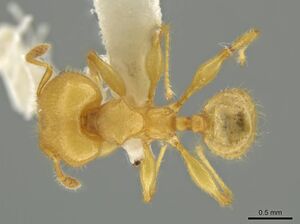Pheidole gilva
| Pheidole gilva | |
|---|---|
| Scientific classification | |
| Kingdom: | Animalia |
| Phylum: | Arthropoda |
| Class: | Insecta |
| Order: | Hymenoptera |
| Family: | Formicidae |
| Subfamily: | Myrmicinae |
| Tribe: | Attini |
| Genus: | Pheidole |
| Species: | P. gilva |
| Binomial name | |
| Pheidole gilva Wilson, 2003 | |
This species is only known from type specimens. The type colony was found in mature terra firme rainforest, nesting in a 8-cm-wide dead branch 3 m from the ground. (Wilson 2003)
Identification
See the description in the nomenclature section.
Keys including this Species
Distribution
Only known from the type locality.
Latitudinal Distribution Pattern
Latitudinal Range: -0.631944444° to -12.497473°.
| North Temperate |
North Subtropical |
Tropical | South Subtropical |
South Temperate |
- Source: AntMaps
Distribution based on Regional Taxon Lists
Neotropical Region: Ecuador, Peru (type locality).
Distribution based on AntMaps
Distribution based on AntWeb specimens
Check data from AntWeb
Countries Occupied
| Number of countries occupied by this species based on AntWiki Regional Taxon Lists. In general, fewer countries occupied indicates a narrower range, while more countries indicates a more widespread species. |

|
Estimated Abundance
| Relative abundance based on number of AntMaps records per species (this species within the purple bar). Fewer records (to the left) indicates a less abundant/encountered species while more records (to the right) indicates more abundant/encountered species. |

|
Biology
Castes
Images from AntWeb
   
| |
| Paratype Pheidole gilva. Worker (major/soldier). Specimen code jtlc000016389. Photographer Skyler Oswald, uploaded by University of Utah. | Owned by MCZC. |
Nomenclature
The following information is derived from Barry Bolton's Online Catalogue of the Ants of the World.
- gilva. Pheidole gilva Wilson, 2003: 427, figs. (s.w.) PERU.
Unless otherwise noted the text for the remainder of this section is reported from the publication that includes the original description.
Description
Similar in various traits to Pheidole angulifera, Pheidole erratilis, Pheidole schmalzi and Pheidole viriosa. Differing as follows.
Major: yellow; humeri in dorsal-oblique view are a “sharkfin” shape, pointing forward, and from above extend just beyond the margins of the pronotum below; propodeal spines more than half as long as the propodeal basal face preceding them; postpetiole from above diamond-shaped; rugoreticulum fills space between each eye and adjacent antennal fossa, and rest of dorsal head surface mostly carinulate; most of dorsal head surface and all of mesosoma foveolate.
Minor: humeri acute-angular, each bearing a long seta at the tip; occiput narrowed, with a nuchal collar; all of head, mesosoma, and waist foveolate.
MEASUREMENTS (mm) Holotype major: HW 1.12, HL 1.10, SL 0.64, EL 0.14, PW 0.56. Paratype minor: HW 0.56, HL 0.62, SL 0.62, EL 0.08, PW 0.38.
COLOR Major: concolorous medium yellow.
Minor: concolorous pale yellow.
Figure. Upper: holotype, major. Lower: paratype, minor. Scale bars = 1 mm.
Type Material
PERU: Cuzco Amazónico, 15 km northeast of Puerto Maldonado, Madre de Dios, col. Stefan Cover and John E. Tobin. Museum of Comparative Zoology
Etymology
L gilva, pale yellow, alluding to color of minor.
References
- Wilson, E. O. 2003. Pheidole in the New World: A dominant, hyperdiverse ant genus. Harvard University Press, Cambridge, MA. (page 427, fig. major, minor described)
References based on Global Ant Biodiversity Informatics
- Fernández, F. and S. Sendoya. 2004. Lista de las hormigas neotropicales. Biota Colombiana Volume 5, Number 1.
